Gainward CoolFX 6800 Ultra/2600 Golden Sample
6. GL Excess
Review Pages
2. Test specifications
3. 3DMark 2003
4. Aquamark 3
5. Codecreatures
6. GL Excess
7. Farcry v1.2
8. Painkiller v1.3
9. Hitman: Contracts
10. X2: The Threat
11. Unreal Tournament 2004
12. Unreal Tournament 2003
13. Halo
14. Tomb Raider : Angel of Darkness
15. Farcry Quality
16. Painkiller Quality
17. Unreal Tournament 2004 Quality
18. Overclocking Capabilities
19. Conclusion
GL Excess
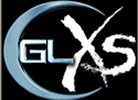 GL
Excess is a very good tool for measuring the performance of VGA cards with
OpenGL applications and games. This benchmark consists of 12 scenes grouped
in
4 categories (3 scenes in 1 category). Each category stresses different OpenGL
graphical sequences. The overall result named XSMark is the sum of the first
scene of each category. All scenes were run in the 1024x768 resolution at 32bit.
GL
Excess is a very good tool for measuring the performance of VGA cards with
OpenGL applications and games. This benchmark consists of 12 scenes grouped
in
4 categories (3 scenes in 1 category). Each category stresses different OpenGL
graphical sequences. The overall result named XSMark is the sum of the first
scene of each category. All scenes were run in the 1024x768 resolution at 32bit.
- Category 1
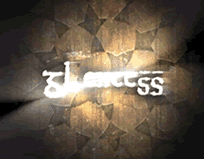
The first category includes scenes 1, 9 and 12. Nothing specific is
stressed on these scenes. Just average use of general OpenGL techniques.
The pic you see is from scene 12 and is made of three shifting and rotating layers, which are textured in 4 blending modes. Nice effect!
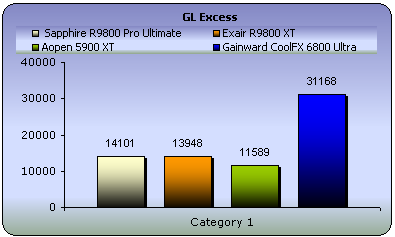
Three-fold performance for CoolFX 6800 Ultra.
- Category 2
 Scenes
3, 5 and 6 stress the card's 3D particle and polygon processing. Particles
are widely used in games and you see them for example when you fire with a
laser beam or when you light up a torch.
Scenes
3, 5 and 6 stress the card's 3D particle and polygon processing. Particles
are widely used in games and you see them for example when you fire with a
laser beam or when you light up a torch.
All 3 scenes are made with a particle system that stresses the card's polygon count and video memory. The spaceship you see in the picture is made of a very large number of polygons.

Again high count of OpenGL polygons were not a problem for Gainward's beast.
- Category 3
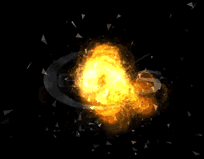
The third category made up of scenes 4, 10 and 11 render the blending ability of the card. Blending is the mixture of the graphic layers that result in complicated textures and effects.
The fill rate of each card is also stressed in these scenes.
So this test should be a reference on the quality of each card.
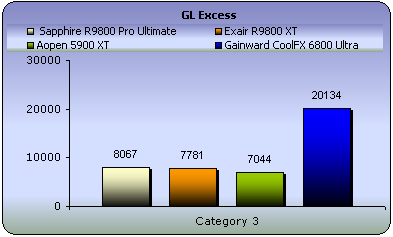
Here, the 6.4 Gpixels/sec pixel fill rate of the 6800 Ultra performed this test with a rather expected score.
- Category 4
 Scenes 2 and 7 that constitute this category have to do with multitexturing effects. Multitexturing is the process of applying two or more textures to a single polygon or pixel, in order to provide spectacular images.
Scenes 2 and 7 that constitute this category have to do with multitexturing effects. Multitexturing is the process of applying two or more textures to a single polygon or pixel, in order to provide spectacular images.
Scene 8 uses a sphere map that is mixed to a simple texturing technique in order to give reflection effects. For your info, the reflection and shadow effects you see in games are accumulated in the stencil buffer.
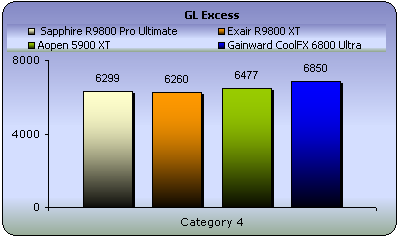
A higher score was expected for the high-toned 6800 Ultra.
XS Marks
The XS Marks is the score awarded by the GL Excess benchmark. Keep in mind that this score doesn't sum up the results of all 12 scenes, but sums up the score for each category's first scene. The XSMarks you get with your card can be posted on the GL Excess web site to compare it with other scores.
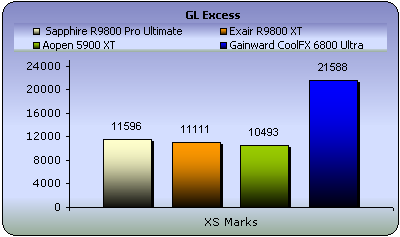
The overall performance of the 6800 Ultra shows that there is no comparison with previous generation VGA cards.
Till now the synthetic benchmarks indicated that Gainward's CoolFX 6800 Ultra is at least 2 times better than the other cards. Now let's see if the situation changes with our game benchmark suite.
Review Pages
2. Test specifications
3. 3DMark 2003
4. Aquamark 3
5. Codecreatures
6. GL Excess
7. Farcry v1.2
8. Painkiller v1.3
9. Hitman: Contracts
10. X2: The Threat
11. Unreal Tournament 2004
12. Unreal Tournament 2003
13. Halo
14. Tomb Raider : Angel of Darkness
15. Farcry Quality
16. Painkiller Quality
17. Unreal Tournament 2004 Quality
18. Overclocking Capabilities
19. Conclusion













